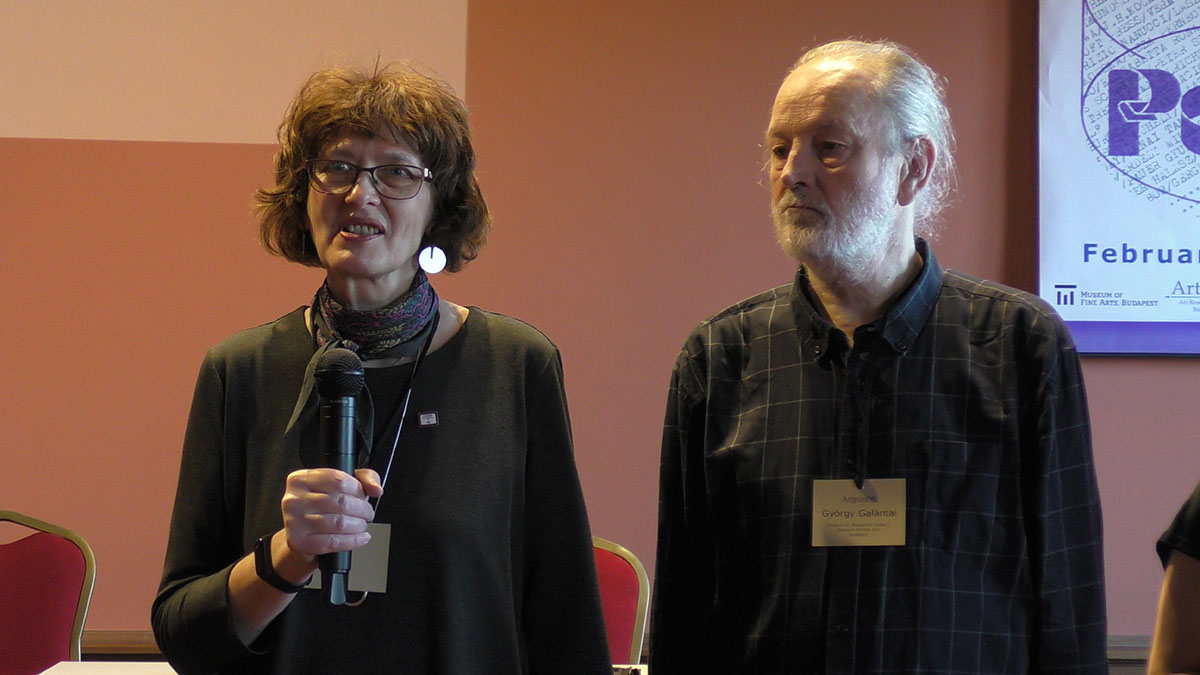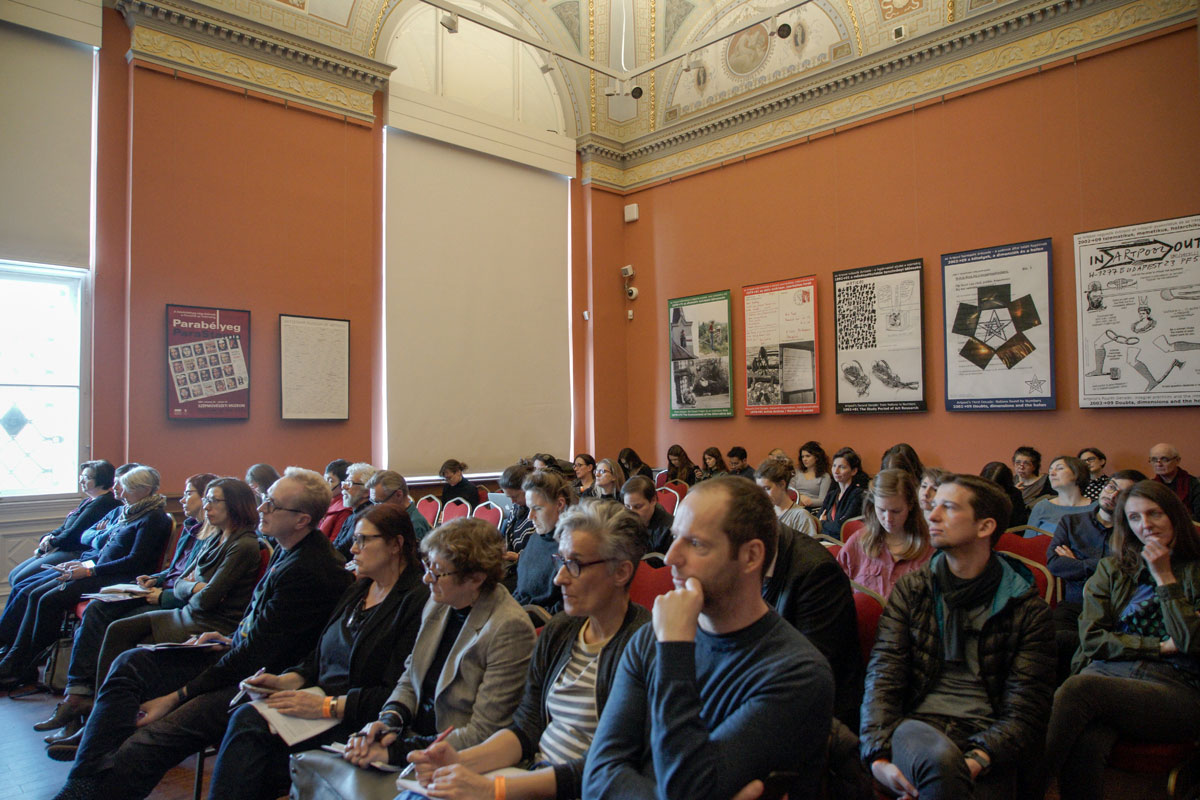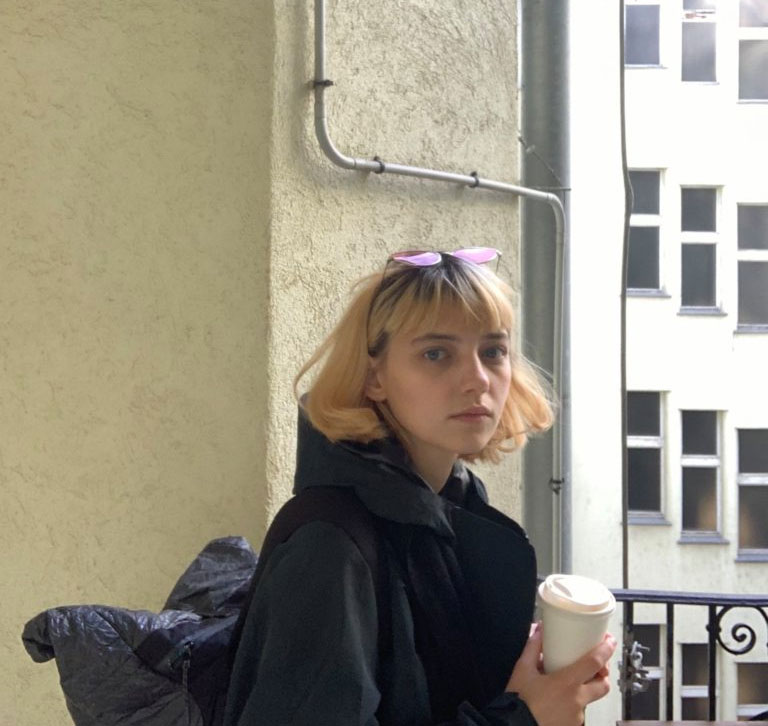The Art of Self-Reflection: Artpool 40 Conference in Budapest
Artpool 40 – Active Archives and Art Networks, Conference at the Artpool Art Research Center, Central European Research Institute of Art History/Museum of Fine Arts, Budapest, February 20–21, 2020.
On February 20, 2020 (an elegant date), a community of artists, scholars, and art enthusiasts gathered at the Museum of Fine Arts in Budapest to celebrate the 40th anniversary of the Artpool Art Research Center.(Éva Forgács, “György Galántai and Júlia Klaniczay, Eds., ‘Artpool: The Experimental Art Archive of East-Central Europe’ (Book Review),” ARTMargins, June 2, 2014, https://artmargins.com/gyorgy-galantai-julia-klaniczay-artpool/.) Artpool was established in 1979 by György Galántai and Júlia Klaniczay (Juliane Debeusscher, “Interview with Artpool Cofounder Júlia Klaniczay,” ARTMargins, June 7, 2011, https://artmargins.com/artpool-cofounder-julia-klaniczay/.). It operated as an archive in the Budapest underground for ten years, collecting art-related materials and facilitating connections between distinct artistic scenes.

Júlia Klaniczay and György Galántai, Artpool 40 – Active Archives, Art Networks Conference, Museum of Fine Arts, Budapest (2020). Photograph by Dóra Halasi.
After the political transition of 1989, the Artpool archive, like so many non-profit cultural organizations, existed in a precarious institutional environment and had to adapt to erratic funding from mixed sources while trying to maintain its independence. Now, after five years of functioning as a separate unit of the Museum of Fine Arts, the archive will be integrated into the MFA’s space as part of the Central European Research Institute of Art History. Against this backdrop, this international conference sought to recognize Artpool’s striking life span and its legacy as an auspicious way of self-reflection.
The organizers of the conference—Júlia Klaniczay, Emese Kürti, and Zsuzsa László (all from Artpool), in collaboration with Judit Bodor (Glasgow School of Art) and Beáta Hock (Universität Leipzig)—emphasized the ideas Artpool has been promoting from the outset, aptly titling the two-day event Active Archives and Art Networks. The concept of the “active archive,” as it was coined by Galántai in 1979, implies a rejection of traditional archival practices as mere passive collection, defying orthodox perspectives on archives as storage spaces.(György Galántai, “Active Archive,” Artpool Art Research Center, https://www.artpool.hu/archives_active.html) It foregrounds a methodology whereby creative and scholarly research strategies mingle, embracing a dynamic attitude towards history as a pre-requisite of future-oriented art. Artpool, following Galántai’s anticipation, has been operating as a platform stimulating and favoring artistic and art historical inquiries. A network of transnational events that brings together artists and scholars of diverse backgrounds, Artpool has been, in Galántai’s words, “an organic and open artwork or an activist kind of art practice.”(Ibid.)
The translation of the concept of the “active archive” into the operational guidelines of Artpool, as well as other methodologies shaping the functioning of archives worldwide, were the primary topics of the conference. The program for the first day sought to tackle the issue primarily from an institutional perspective: moving from specific research cases to generalizations, the speakers delineated the major shifts in the everyday running of archives, singling out the hopes, the misfortunes, and the lessons learnt.(For the conference program and the video recordings of the lectures see “Artpool40 – Active Archives and Art Networks. International Conference of the Artpool Art Research Center,” Artpool Art Research Center https://www.artpool.hu/institute/artpool_40-conference.html.) A substantial discussion addressed those methodological chinks that conspicuously manifest themselves in the collecting and developing of taxonomies.

Artpool 40 – Active Archives, Art Networks Conference, Museum of Fine Arts, Budapest (2020). On the walls posters by György Galántai. Photograph by Csanád Szesztay.
The talks by Lina Džuverović and Tomasz Załuski were particularly illuminating with respect to how tacit assumptions about historical events made by artists, scholars, and archival staff regarding the materials presented in archival collections may alter the way they are studied. Džuverović, focusing on the collective creative practice of Yugoslav groups such as OHO, Bosch+Bosch, and the Podroom initiative, demonstrated that gender-based exclusion in their historicization is sustained by narratives that are reinforced uniformly by female and male artists. Załuski outlined the operation of KwieKulik’s Studio of Activities, Documentation and Propagation (Pracownia Działan Dokumentacji and Upowszechninia, PDDiU) in Poland of the 1970-1980s. Building on the case of PDDiU as “an active and performative archive,” Załuski proposed the term “alternative official” in order to move beyond the habitual but simplistic dichotomy of “official” versus “unofficial” which is ill-equipped to grasp the complexity of centrally controlled cultural experience.
The highlight of the discussion regarding the methodologies guiding archival performance was the debate over the artists’ approach to archives. Ljubljana-based Zdenka Badovinac spoke to self-documentation and self-historicization as strategies practiced by artists. Drawing on the case of the Temporary Slovene Dance Archive (TSDA) in particular, Badovinac demonstrated how from an institutional context artist archives may aid museums in developing critical multi-narratives, covering formal and informal histories and accounting for the tensions between them. She also pointed out that artists who practice self-documentation implicitly take on the role of an activist, and this activist position should persevere in the archival operation like in Galántai’s conception of the “active archive.”
Resonating with this line of thinking, Sven Spieker thoroughly analyzed “destruction” as an extreme form of artistic engagement with archives. As highly organized institutions, archives simultaneously accumulate and destroy. Spieker underscored that destruction is essential for an archive’s ability to incorporate new materials, and he described how the spectrum of what he termed “archivo-philic” and “archivo-phobic” attitudes manifests itself in different art projects. Continuing this line of thought, Kaja Kraner offered a close analysis of the legacy of the Lebanese artist Walid Raad, who also utilizes historical documents in his creative practice, concentrating on Raad’s most famous project, the Atlas Group Archive, and his ongoing work Scratching on Things I Could Disavow: A History of Art in the Arab World. Kraner asserted an urge for an innovative conceptualization of archives as artworks which are engineered at the intersection of memory, history, and fiction.(“Art | The Atlas Group | Lebanon | Walid Raad,” https://www.theatlasgroup1989.org.)
Daniel Grúň brought a more distinct approach to “the artist and the archive” discussion. Using five monographic archives by artists Stano Filko, Július Koller, Jiři Valoch, Ján Zavarský and Miloš Laky, he disentangled the arrangement of the event White Space in White Space project (1973–1974). Grúň’s reconstruction encouraged reflection on how historicization and self-historicization come together as self-interpretative systems used by artists in order to construct archival collections. In a similar context, Emese Kürti and Katalin Cseh-Varga illuminated the subtleties of Artpool’s history and György Galántai’s career, and their interconnection. Kürti’s lecture, which outlined the archive’s conversion from an underground project to the state-run public sphere, was a milestone for the conference, while Cseh-Verga, through an examination of Galántai’s diaries and notebooks, traced self-reflexivity as part of the artist’s legacy.
Karolina Majewska-Güde carried out an investigation into artists’ archives, especially with regard to the Ewa Partum Archive and the VALIE EXPORT Research Center, placing the vicissitudes of their operation in the context of the art infrastructure in Poland and Austria, respectively. Sarah Haylett shared with the audience thought-provoking insights from her professional experience of working as an archivist at the Tate Gallery and taking part in its Reshaping the Collectible project.(“Reshaping the Collectible: When Artworks Live in the Museum – Project,” Tate, https://www.tate.org.uk/about-us/projects/reshaping-the-collectible.) Her lecture added a substantial dimension to the discussion, unpacking the “archivist” component, particularly in artworks from the Tate’s collection, such as Jeremy Deller’s The Battle of Orgreave Archive (An Injury to One is an Injury to All) (2001), Yinka Shonibare CBE (RA) The British Library (2014) , Paweł Althamer’s Film (2000), or Tania Bruguera’s Tatlin’s Whisper #5 (2008).
On the second day, the conference shifted the focus to the media of archiving, network theories and mail art. The previous day’s discussion reverberated once again in the video-taped lecture by Kristine Stiles and in presentations by Henar Rivière and David Crowley, who all gave due attention to collection as a strategy of self-historicization. Stiles shared the experience of compiling her personal archive and elaborated, in a genuinely self-reflective way, on how the representation of herself and East European artists in that collection was constitutive for her understanding of what archives do, which in its turn modified her collecting habits. Rivière explored the deliberate artist-guided assemblage of the “Other Archives” as part of the Fluxus, and David Crowley presented a perceptive analysis of creative practices developed in the 1970s-1980s by artists Mikhail Epstein, Viktor Pivovarov, Ilya Kabakov, and Andrei Monastyrski of the Collective Actions group, and articulated their archival longing as part of a “bureaucratic aesthetics ” peculiar to the Soviet imaginary.
Addressing the hybrid reality of contemporary archives as spreading across the analogue and the digital realm, the conference included a panel where participants interrogated the impact of media technologies on archives. On the opening day, this subject was touched upon in Jasna Jakšić’s overview of the complex influence digital archives have had on the research into the work of modern and contemporary Croatian artists. The discussion about digitality as transformative for both archival collection and preservation also seeped into some of the panel conversations, especially into Elisabeth Zimmermann’s lecture on the online archive of Ö1 Kunstradio(“RADIOKUNST – ONLINE SINCE 1995 – KUNSTRADIO,” http://kunstradio.at/ and the presentation of Artpool’s virtual presence,(“Artpool Art Research Center,” Artpool Art Research Center, http://artpool.hu/), presented by Roddy Hunter and Judit Bodor.
Agustina Andreoletti’s detailed analysis of how digital archives, defined by her as “shadow libraries,” form and circulate as a reaction to the restrictions placed on knowledge and to censorship brought up questions regarding the legal framework in which archives exist, especially with regard to copyright. Meghan Forbes demonstrated how East German underground art magazines of 1980s such as Anschlag, Schaden, and Common Sense took on the role of historical documents and can help illuminate understudied historical events as well as the ties that existed between different artists involved in counter-cultural production. Through her conceptualization of magazines as archives, Forbes underscored the understanding of the “active archive” as a platform, and her talk served as a relay between the panels on archive media and mail art networks, respectively.
Mail art constituted its own subject at the conference, not least because György Galántai’s activities within the international mail art scene had done much to advance Artpool’s global reputation. John Held Jr., who has been a prominent mail art practitioner since the 1970s, provided crucial firsthand insights into the development of mail art in the United States, and problematized its current reception in archives and exhibitions. Katalin Timár shared with the audience her recollections of art-historical education in socialist Hungary, while revising the theoretical stakes of her 1990 dissertation which had conceptualized mail art as an artistic movement. Klara Kemp-Welch provided an intriguing glimpse of the genesis of her complex research project Networking the Bloc: Experimental Art in Eastern Europe 1965-1981(Cristian Nae, “Networking the Bloc: Experimental Art in Eastern Europe 1965-1981,” ARTMargins, November 26, 2019, https://artmargins.com/networking-the-bloc-experimental-art-in-eastern-europe-1965-1981-book-review/.), which helped our understanding of the Eastern European art milieu not least through its network-based methodology.
The conference celebrating Artpool’s 40th anniversary was an invigorating event, bringing to bear cutting edge thought on archival practice from both artistic and scholarly perspectives. Indeed, the institutional trajectory of Artpool accommodates a variety of captivating subjects, provokes reasoning with compelling case studies, and stimulates critical inquiries into archival, artistic and curatorial methodologies. Although the matter of the archive’s future was absent from the post-panel discussions, it resurfaced as a pertinent question, posed as a concluding remark. In 1979 Galántai stated that one of Artpool’s aims was “to collect material for the museum of artistic inventions scheduled to open in 2079,” specifying the material as “artistic experiments which, under the present circumstances, would disappear without a trace.”(György Galántai, “Galántai’s Diary – Network/Institutions 1970-93,”Artpool Art Research Center, http://www.galantai.hu/diary/Network_Institutions.html.) Midway between the underground and a museum, Artpool, hardened by years of turmoil, now faces a new chapter of uncertainty, given its dependence on the state-run institutions and on the goodwill of the authorities. The self-historicization provided by this conference will definitely benefit from (self-) documentation in the form of conference proceedings.




